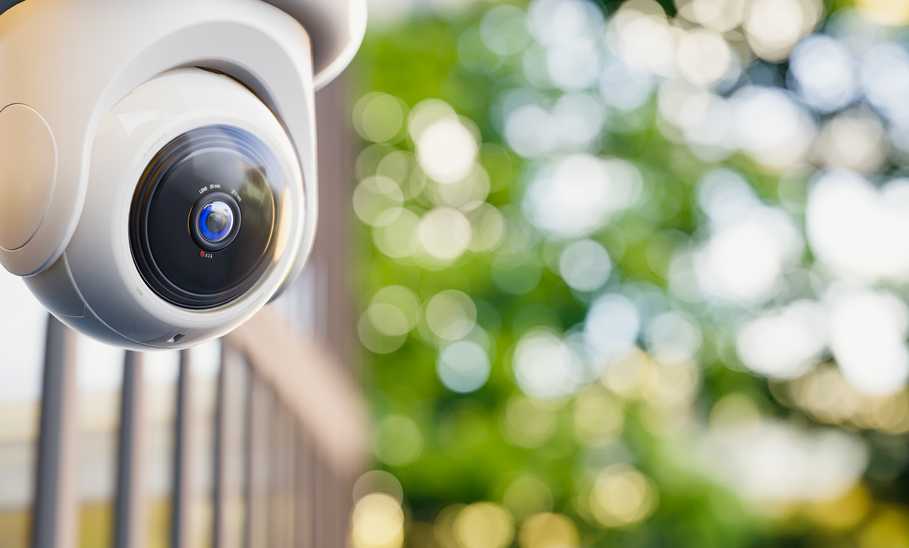Protecting yourself, your family, and your property are always important considerations. According to a 2023 survey from SafeHome.org, at least 72% of United States homeowners opt for some kind of home security system. In addition, according to a study conducted by the Chamber of Commerce, over a quarter of U.S. homeowners in 2023 were victims of package theft.
As someone who lives on an upper floor in a Manhattan apartment building who has personally experienced package theft, I am always thankful for our video/audio doorbell/entry buzzer system. It records every time someone buzzes an apartment, shows you who is outside before you let them in, and also has security cameras on each floor landing. Our doorbell video system helps mitigate the possibility of buzzing in a potential thief.
If you’re thinking of investing in some security cameras here are some things to consider.
Our top picks for the best security cameras

Lorex 4K Indoor/Outdoor Security Cameras
The new 4K Dual Lens Camera from Lorex is unique in that it has 2 lenses in a single camera housing that allows it to capture a 180° view (the widest of all the cameras included). “This means you install less cameras and monitor more,” says Epstein.
Other features include 2-way talk capabilities, auto framing, spotlight function, an in-camera Edge AI, and color night vision. It's super easy to install and use via the Lorex App or Google Home or Alexa.
Specifications
- Resolution: 4K
- Connectivity: Wi-Fi
- Smart platform compatibility: Lorex App, Google Home, Alexa
- Field of view: 180°
- Video storage: 32 GB microSD (upgradeable to 256 GB)
- Power source: Wired electricity
- Setup: DIY
- Weather resistant: Yes, IP66 weatherproof
- Motion detection feature: Yes; person, vehicle, animal, and package detection
- Color: Yes, plus night vision
- Warranty: 1 year; extended plans available for purchase
- Price on publish: $199.99
Pros:
- Dual lenses for wider view
- Auto framing
- 2-way talk
The bottom line:
This new dual lens security camera from Lorex has a wide view angle, spotlight function, color night vision, and auto framing.
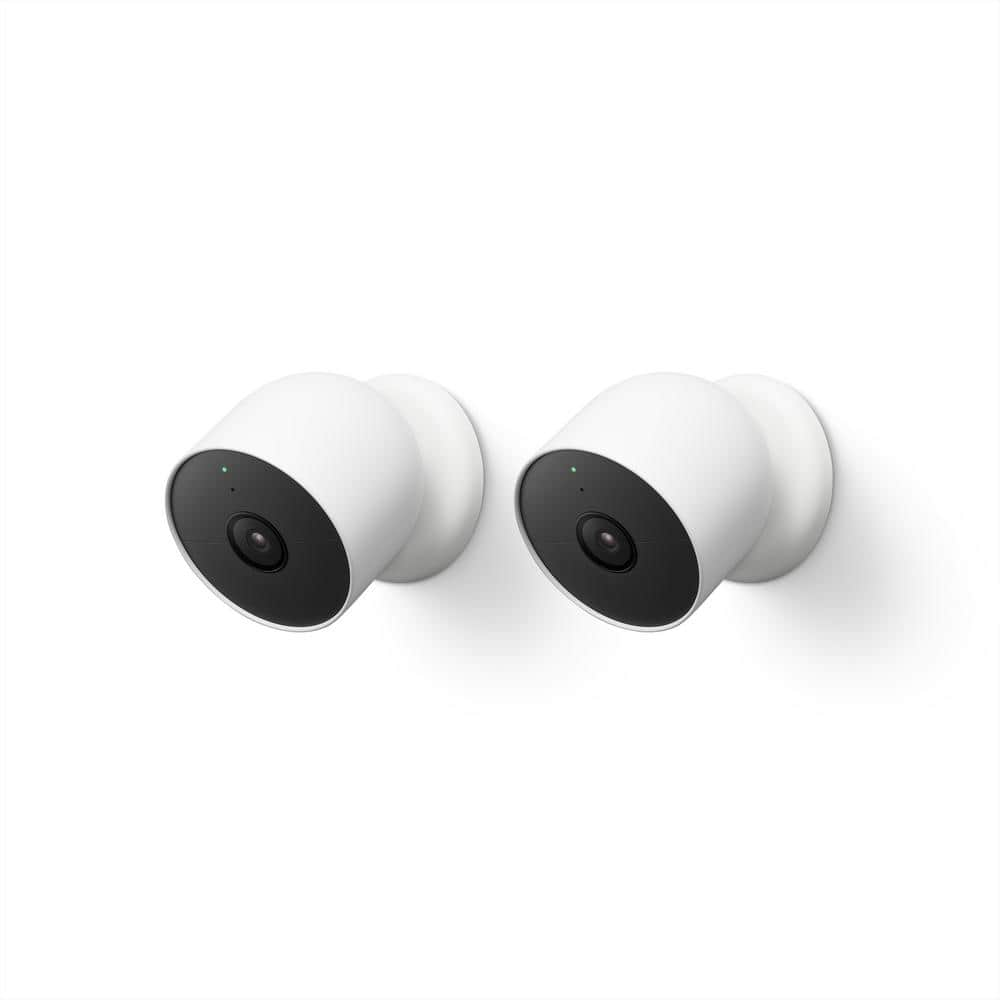
Google Nest Cam Indoor/Outdoor Wire-Free Security Camera
24% offSave $80
Battery powered and weather resistant, the Nest Cam features integrated intelligence that distinguishes the difference between human, animal, and vehicle and sends alerts in real time to your Google Home App. Add Nest Aware and it can even recognize familiar faces.
The Nest stores up to 3 hours of video for free. Like many of the cameras included here, it only records when something activates it, such as a person coming up to your front door. Add a weatherproof cable for continuous power and recording when positioned outdoors or a convenient indoor stand when set up inside.
Specifications
- Resolution: Full HD 1080p
- Connectivity: Wi-Fi
- Smart platform compatibility: Google Home (required), Alexa
- Field of view: Wide angle 130°
- Video storage: Cloud storage for monthly fee; local storage of up to 3 hours
- Power source: Battery powered, cable with AC adaptor plug-in
- Setup: DIY
- Weather resistant: Yes
- Motion detection feature: Yes
- Color: White with black accents
- Warranty: 1 year
- Price on publish: $329.99 for two
Pros:
- Stores 3 hour of video without a subscription
- Options to power via battery or wired cables
- Transmits hands-free video to smart screens, including TVs, phones, and tablets
Cons:
- Not resistant to extreme cold
The bottom line:
The Nest Cam is an outdoor, weatherproof camera from Google that offers 3 hours of free video storage and both battery and wired power options.

Arlo Essential Wireless Security Camera
The Essential Camera from Arlo includes 130° field of view, 2-way audio capabilities, color night vision, up to 300 feet sight range, an integrated spotlight and a configurable siren to scare off any unwanted visitors. It’s available in both HD and 2K video resolution and features wire-free installation with a rechargeable battery.
Set up is super simple; just download the app and charge your camera, then install the mounting plate with screws and slide the camera in place. That’s it.
Specifications
- Resolution: HD 1080p or 2K
- Connectivity: Wi-Fi
- Smart platform compatibility: Arlo Secure App, Alexa, Google Home, IFTTT
- Field of view: 130°
- Video storage: 30 days in cloud
- Power source: Rechargeable battery
- Setup: DIY
- Weather resistant: Yes
- Motion detection feature: Yes
- Color: White with black accents or black
- Warranty: 1 year
- Price on publish: $69.99
Pros:
- Easy installation
- Color night vision
- Works with multiple smart platforms
Cons:
- Some reviewers report the batteries don’t last as long as you’d expect
The bottom line:
Wireless, easy to install outdoor camera with lots of features including a floodlight and siren.
Best outdoor wireless security camera: Blink Outdoor 4
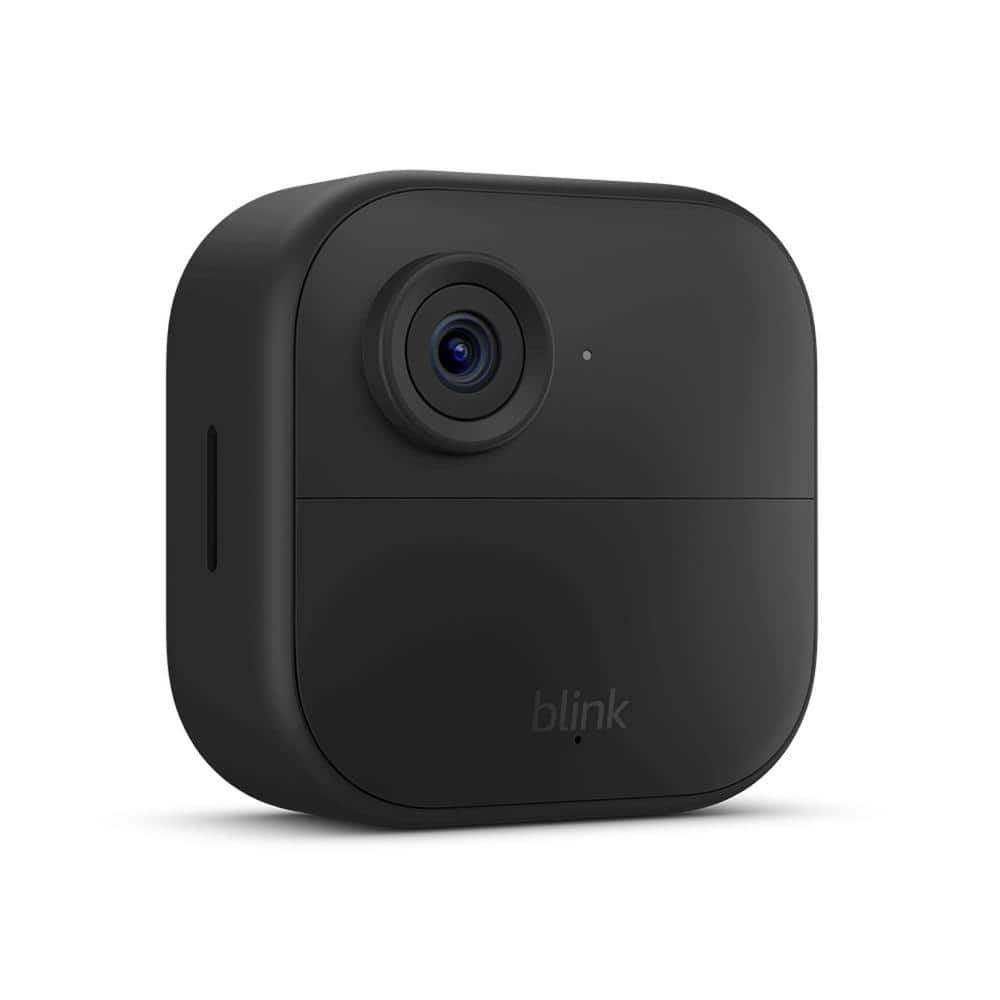
Blink Outdoor 4
50% offSave $50
Blink Outdoor 4 cameras feature full HD resolution for clear images even when the weather is anything but, as well as a completely wire-free installation. They offer a broader field of vision than many others—an ultra-wide 143° (though this means some precise detail can be lost). Its night vision functions in black and white mode and it works in temperatures ranging from -4 F to 113 F. While a bit basic compared to some cameras with more features, it offers solid, reliable performance on a budget.
Specifications
- Resolution: Full HD 1080p
- Connectivity: Wi-Fi
- Smart platform compatibility: Alexa
- Field of view: 143°
- Video storage: Cloud subscription; local with Sync Module or USB drive
- Power source: 2 AA lithium batteries
- Setup: DIY
- Weather resistant: Yes
- Motion detection feature: yes
- Color: Black
- Warranty: 1 year
- Price on publish: $99.99 for one, $179.99 for two
Pros:
- Great value
- Easy set up
- Easy to operate via the app
Cons:
- Not as many features as some others
The bottom line:
The Blink Outdoor 4 is a good, basic wireless camera with motion detection and black and white night vision.
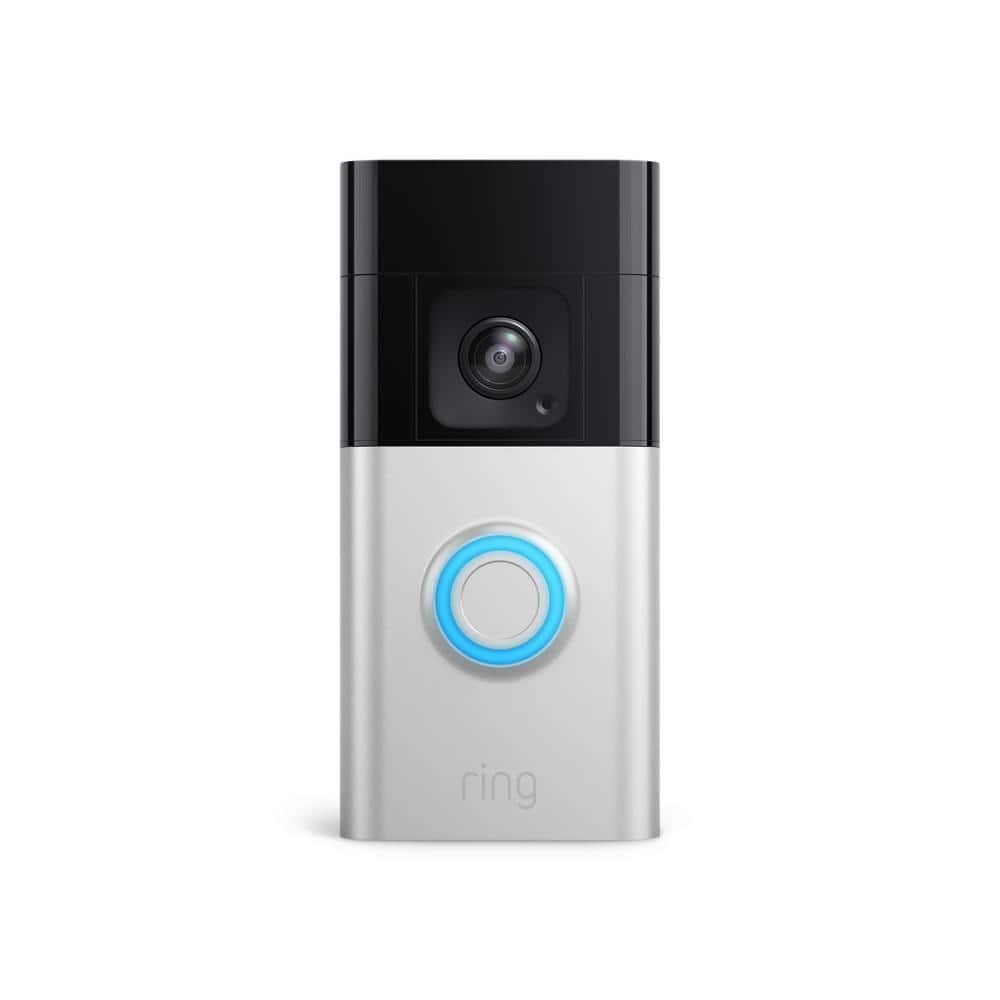
Ring Battery Doorbell Pro
35% offSave $80
The Ring Battery Doorbell Pro provides two-way talk with audio plus motion detection and head to toe video. It’s almost like having a full time doorman—if your doorman were an AI named Alexa. The 3D motion detection means you can configure bird’s eye zones up to 30 feet away via an overhead map that allows you to pinpoint exact locations. It also features excellent sight and clear color even in low light conditions.
Add on a Package Alert subscription to take full advantage of your very own personal Alexa powered doorman.
Specifications
- Resolution: HD 1536p (2K)
- Connectivity: Wi-Fi
- Smart platform compatibility: Ring App, Alexa
- Field of view: Wide; bird’s eye view; 150° horizontal and vertical
- Video storage: Cloud with subscription plans
- Power source: Quick release lithium-ion battery pack
- Setup: DIY
- Weather resistant: Yes
- Motion detection feature: Yes, features 3D motion detection
- Color: Silver and black
- Warranty: 1 year
- Price on publish: $229.99
Pros:
- Quick release battery
- 3D motion detection
- Low-light sight capabilities (15 feet night vision distance)
The bottom line:
Ring Battery Doorbell Pro features motion detection, customizable zones and video storage options (with a subscription), and excellent low-light sight.
Best outdoor security camera without a subscription: Eufy Cam S330
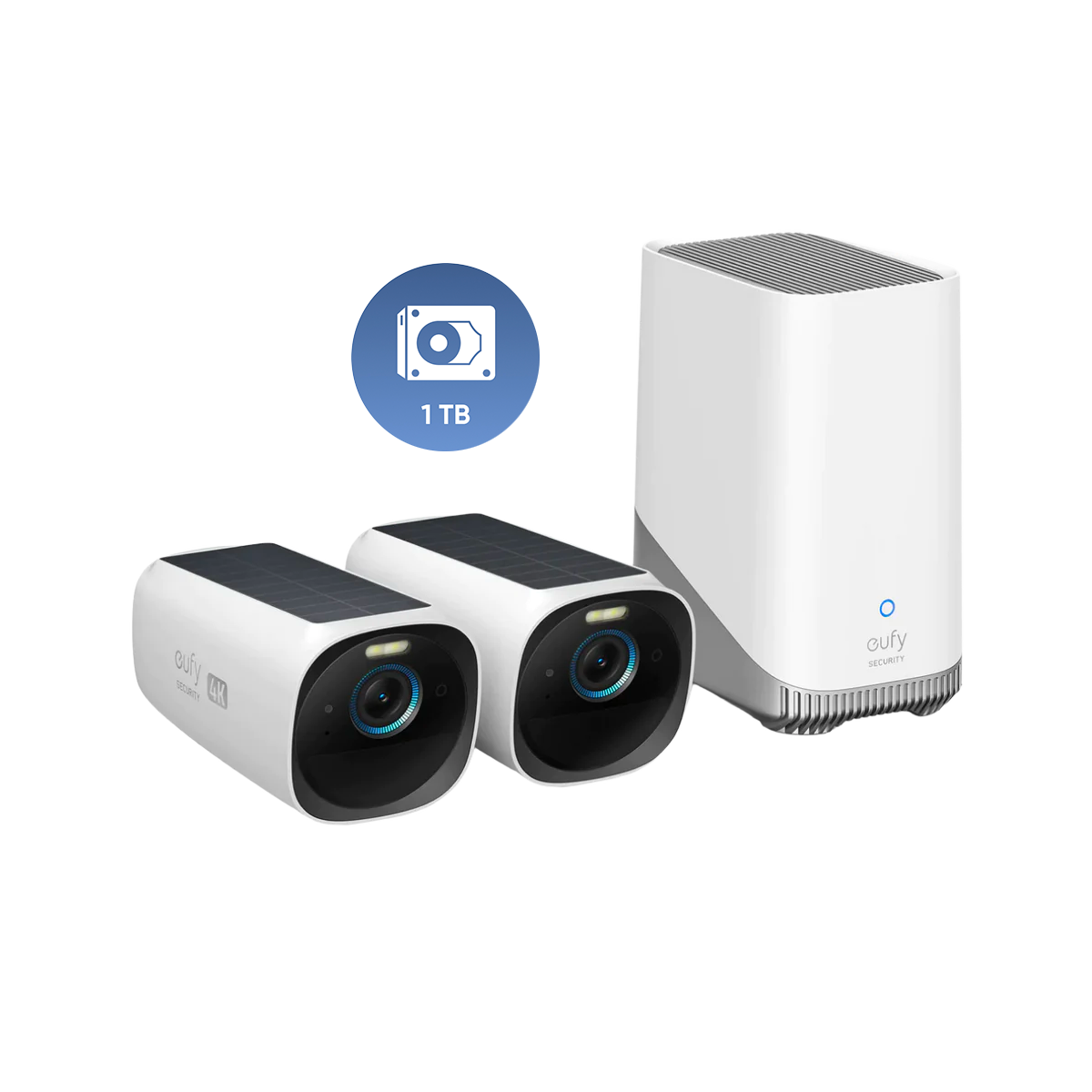
Eufy Cam S330
33% offSave $210
This Eufy Cam package contains two security cameras with solar power and a 1 TB hard drive that stores up to 15 years of footage. It’s expandable up to 16 TB which equals a whopping 240 years of storage; more than you will likely ever need with no need for a subscription.
There’s also 16 GB of local storage on each camera, two-way audio capabilities, a starlight photosensitive system, and robust weather protection. The battery lasts for one year on a single charge and the self-learning AI includes facial recognition and human, pet, and vehicle detection.
Specifications
- Resolution: 3840 x 2160 (4K)
- Connectivity: Wi-Fi
- Smart platform compatibility: Alexa, Google voice
- Field of view: 135°
- Video storage: 16 GB local built in, up to 16 TB expandable storage drives
- Power source: Battery, integrated solar panel
- Setup: DIY
- Weather resistant: Yes, IP67 weatherproof
- Motion detection feature: Yes
- Color: White and black
- Warranty: 1 year
- Price on publish: $519.99 for two plus a 1 TB hard drive storage
Pros:
- Built-in solar panels
- Expandable storage
- Completely wireless
Cons:
- Some reviewers report a motion detection delay
The bottom line:
The Eufy Cam S330 is a full-featured security camera system with 1 TB hard drive storage and built-in solar power.
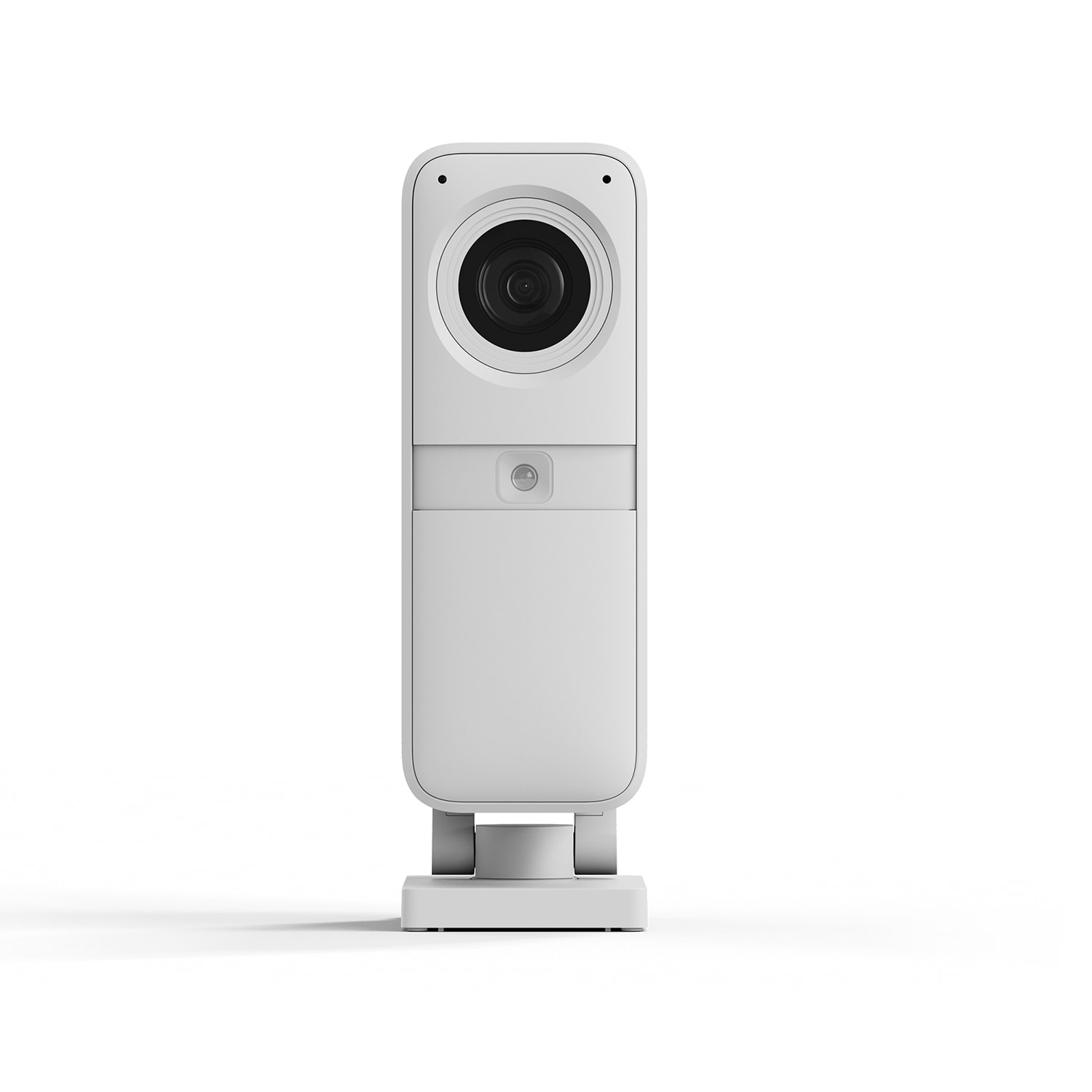
SimpliSafe Smart Alarm Wireless Indoor Security Camera
The SimpliSafe Smart Alarm camera sounds a screeching alarm when it detects an intruder and includes the option of 24/7 live guard monitoring with a subscription to monitor your business or home.
Completely wireless and battery operated, you can install this camera wherever you need extra peace of mind: in an office with computer equipment, near the safe, or in storage rooms. It features a wide angle 139° view, a privacy shutter, 2K video resolution, and advanced AI-powered motion detection which helps cut down on false alarms.
Specifications
- Resolution: HD 1536p (2K)
- Connectivity: Wi-Fi
- Smart platform compatibility: SimpliSafe Gen 3, app for Android or iOS
- Field of view: Wide, 121° - 139°
- Video storage: Cloud storage with subscription plan
- Power source: Battery
- Setup: DIY
- Weather resistant: No
- Motion detection feature: Yes
- Color: White
- Warranty: 1 year
- Price on publish: $124.99
Pros:
- Loud alarm to deter intruders
- Easy installation
- Optional 24/7 monitoring with subscription
Cons:
- Some reviewers report slow load times of camera image on app
The bottom line:
SimpliSafe Smart Alarm Wireless indoor security cameras feature an alarm and advanced motion detection capabilities.
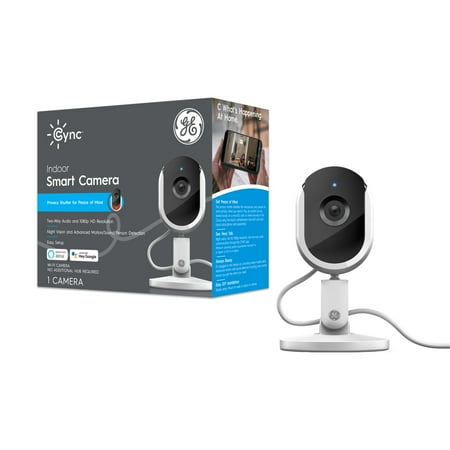
GE Cync Indoor Smart Camera
34% offSave $17
The Cync Indoor Smart Camera from GE includes a privacy shutter, two-way talk capabilities (controllable via Alexa or Google Assistant), and advanced motion and sound detection. A wired camera, it’s always on and poised to send you mobile alerts whenever it detects something or someone suspicious.
The camera is easy to install on a shelf or wall with the included bracket.
Specifications
- Resolution: HD 1080p
- Connectivity: Wi-Fi
- Smart platform compatibility: Cync App, Google Home, Alexa
- Field of view: Wide
- Video storage: Cloud and local (built-in SD drive)
- Power source: Corded electricity
- Setup: DIY
- Weather resistant: No
- Motion detection feature: Yes
- Color: White with black accents
- Warranty: 2 years
- Price on publish: $31.99
Pros:
- Great price
- Easy to install
- Works with smart home applications
Cons:
- Not many advanced features
The bottom line:
A quality, basic, wired indoor camera with motion and sound detection that works with Alexa and Google Assistant.

Swann Full HD DVR Security System
The Swann security camera system includes two 1080p thermal-sensing security cameras, a 4-channel digital video recorder with 1 TB hard drive, and both VGA and HDMI outputs supported by Windows and Mac OS. You can also set up your system to upload footage to your Dropbox account automatically. While the system will work with a Wi-Fi connection by adding a USB Wi-Fi antenna, the company recommends using a wired ethernet cable if possible.
The cameras feature a 90° viewing angle, night vision up to 100 feet, and thermal and motion sensors. This is a wired system, so you’ll have to spend some time planning your camera positions and figuring out how to run your cables, but it’s nothing someone with general home maintenance and repair knowledge can’t accomplish on their own. (Though, if you’re climbing a ladder, have a buddy around to avoid being a part of that stat of people injuring themselves while installing security systems.)
Specifications
- Resolution: HD 1080p
- Connectivity: Wi-Fi
- Smart platform compatibility: Swann Security app, Hey Google, Alexa
- Field of view: 90°
- Video storage: 1 TB via included hard drive; can upload to Dropbox
- Power source: Wired, power adaptor
- Setup: DIY
- Weather resistant: Yes
- Motion detection feature: Yes
- Color: White w/black accents
- Warranty: 1 year
- Price on publish: $199.99 for two plus 1 TB hard drive
Pros:
- Heat and motion sensing
- Excellent budget friendly price
- Works with most smart home systems
Cons:
- USB Wi-Fi antenna costs an additional $30
The bottom line:
Swann’s Full HD wired security camera system comes with two thermal and motion sensing cameras and a 4-channel digital video recorder with 1 TB of storage.
Most affordable security camera: Wyze Cam Pan v3
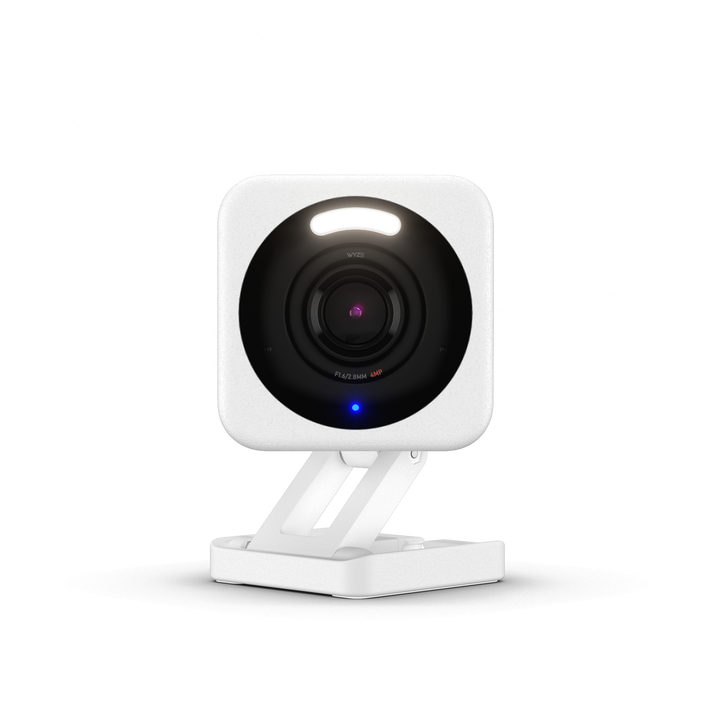
Wyze Cam Pan v3
At about $40 each (though they’re often on sale for less than that) the Wyze Cam Pan v3 is one of the most affordable security cameras available. With 2-way audio, color night vision, motion sensing, hardy weather resistance, and smart platform compatibility, they’re not stingy with the features either. Add a Cam Plus subscription for unlimited cloud storage and person, vehicle, pet, and package detection.
Other optional accessories include a spotlight kit and Wyze lamp socket that you can install in your outdoor light fixture. The socket is equipped with a USB port to plug in your camera which provides power while also allowing you to control the light via the Wyze App.
Wyze Cams are available in white or black (for stealthier installations).
Specifications
- Resolution: 1080p
- Connectivity: Wi-Fi
- Smart platform compatibility: Google Assistant, Alexa, IFTTT
- Field of view: 120°
- Video storage: Local 256 GB microSD card; cloud with subscription
- Power source: Power adaptor
- Setup: DIY
- Weather resistant: Yes, IP65 weatherproof
- Motion detection feature: Yes
- Color: White w/black accents, black
- Warranty: 1 year
- Price on publish: $39.98
Pros:
- Budget friendly
- Comes in two colors
- Excellent features for price
Cons:
- Some reviewers report connection issues
The bottom line:
Wyze Cam Pan v3s are budget-friendly, wired, full featured smart cameras with motion sensing, weather resistance, 2-way audio, color night vision, and they’re available in white or black.
What to consider when buying a security camera
Wired versus wireless
Gilad Epstein, CEO at Lorex Technology, a manufacturer of home security systems, says both wired and wireless cameras possess certain advantages. They each provide unique security solutions for different customer needs.
A wired system utilizes a wired connection for both power and recording with a wire or cable running from the camera to the recorder. This setup allows you to view the cameras using the recorder interface on either a monitor screen or through a mobile app. In most instances, this provides 24/7 continuous recording, documenting every moment. When paired with a 1TB or 2TB hard drive, the system stores months of recordings.
“Wired systems,” says Epstein, “feature enhanced reliability due to their ability to record even without the internet.”
On the other hand, wireless security cameras and systems utilize Wi-Fi and battery power. They connect to a video storage device (or cloud storage) via an internet or, sometimes, a Bluetooth connection. The footage can be viewed through a mobile app. Wireless cameras provide enhanced flexibility of angle of view, are often easier to install and can reach distances that may be difficult for wired cameras to reach.
“For instance,” says Esptein, “Some of our Lorex battery operated Wi-Fi systems have a range of over 2,000 feet allowing for comprehensive monitoring.”
DIY versus professional installation
You can install most security cameras by yourself though wireless ones are, of course, much easier. Vivint, a security system company, recently surveyed 1,000 homeowners and renters who have at least one security device installed in their home and 186 contractors with experience installing home security devices. The survey found that one in four homeowners suffered an injury when self-installing home security features, and those who erred in their self-installation attempt spent an average of $188 to rectify their mistakes. In other words, plan out your installation, take your time while doing it (e.g. have someone steady your ladder!), and double check all connections.
The study also found that neglecting maintenance was the #1 most costly self-installation mistake, which garnered an average of $405 to fix. For more on this, check out the maintenance guide at the end of this article!
Additional features
Elaine Smith, Director of Product at Ring, says that both Ring and Blink products include built-in motion sensors that alert you in real-time when motion is detected. Most of the other cameras included in my list do that as well.
Another feature to consider is the ability to set up motion zones which allow you to adjust the sensitivity of the camera and control your notifications.
Other features to look for include live view and 2-way talk. These allow you to see what is happening and communicate with someone even if you’re not home (via the companion app or smart home app like Alexa or Google Home).
“Ring and Blink cameras work with Alexa, meaning they can be integrated into your other smart home devices to work seamlessly together to create a smarter, more secure home that can be controlled from your phone or tablet,” said Smith. Cameras from the majority of other manufacturers have this feature as well.
Also consider battery life and how the battery needs to be charged.
Installation and setup guide
Where to place your cameras and how many you should have
Outdoors
Epstein says that the two most common outdoor locations include a video doorbell at the front entrance and a video floodlight above the garage and/or the side and backyards. He suggests placing cameras in the following locations for outside monitoring:
- Above the garage to monitor cars and deter car theft and break-ins
- At the front door for notification of visitors and package delivery
- Side of the house to monitor activity within a low-traffic area
- At the backyard entrance to monitor human and animal activity, increasing awareness when you’re not present
The formula he recommends for deciding how many cameras you need is:
- 40 feet x 50 feet property lot: 1 - 3 cameras
- 50 feet x 100 feet property lot: 4 - 6 cameras
- Over 100 feet x 1000 feet property lot: 6 - 8 cameras
Jeff Ketelaars, co-founder of Security Guards Only, says the thing to remember is to cover all access points, including the front door, garage, backdoors, and large windows. If you have them, think about side walkways and your driveway/front sidewalk as well. If you share these spaces with neighbors, ask for their consent; they may even be willing to share the cost.
“Anywhere that is considered publicly accessible, such as front yards, is not a violation of privacy to film,” says Ketelaars, “so you do not need to worry about capturing a bit of your neighbor's property within the feed.”
Indoors
Indoor cameras are useful for monitoring young children or elders, as well as for remote check-ins when away. They can alert you to break-ins, flooding, fire, or other incidents, explains Epstein.
For indoor installation, Epstein suggests installing one to four cameras, depending on the application, in the following locations: the garage, a baby playroom, the basement or utility room, and your home office.
“You don’t need as many cameras inside”, says Ketelaars, “especially since you’ll want to keep bedrooms and bathrooms private.” Generally, he recommends having one in the front and back access points to capture anyone coming into the home. If you also want to monitor activity in your main living spaces, such as the kitchen or living room, he suggests placing cameras strategically so that they capture most of the area from one feed, such as under a TV system at eye level or on top of high cabinets pointing downward.
Privacy and data security
Victor Zyamzin and the team at Qrator Labs, a company that provides network security solutions for companies and individuals, advise always changing the default settings of any security system or camera you install. One of the most common risks is a data breach which can lead to your security camera images being leaked online; something nobody wants.
“Change all the default passwords to a robust, distinct password or passphrase,” says Zyamzin. Many IP cameras don't have a password turned on by default, so don't forget to set it. Otherwise, you are leaving the device open to anyone.
It’s also crucial to change your camera's default admin name and password, which are often set by the manufacturer. Information on how to do this will be found on the manufacturer’s website in the support section for your device model.
“If you leave it unchanged, even the most inexperienced hacker can look it up and gain access to your camera,” says Zyamzin. And don’t forget about a password for your cloud account either, if you’re using one.
Certain cameras operate without the need for passwords or logins and directly connect to the cloud and begin streaming video from various locations, he explains. Without adequate protection, you run the risk of your content being leaked online or exploited for blackmail, especially if it contains sensitive information.
The Qrator Labs team’s other tips include the following:
- Keep your camera on a local network and assign it non-routable internal IP addresses.
- Connect only to a WPA2- or WPA3-encrypted wireless network which prevents wireless eavesdroppers from connecting and accessing your video feeds.
- Regularly update your device's software and firmware, which helps protect your device and data from constantly evolving malicious programs.
Remember that cameras can be targeted by hackers, resulting in the leakage of users’ images onto the internet or in someone surveilling you and your family without your knowledge, just like the situations that are often portrayed on procedural crime dramas like NCIS and Law and Order. Unsecured cameras connected to Wi-Fi can also become instruments of DDoS attacks.
Ketelaars recommends researching and reading the fine print about how any video or audio footage is stored by whatever company or cloud service you’re using. “For example,” he says, “there have been scandals with Ring security systems around illegal surveillance by employees. Data breaches are always a risk with this type of technology, so be diligent about what you choose to record when setting up your own cameras.”
Smith says that privacy, security, and customer control are fundamental to Ring and Blink. “Our goal is to develop products, features, and services that focus on the privacy and security of not only our customers, but also empower them to respect the privacy of their neighbors,” she says.
Ring and Blink offer features like privacy zones and toggles for audio streaming and recording. Ultimately, you, the customer, are responsible for using your devices appropriately, avoiding public spaces and neighboring properties, or, if necessary, providing notice to neighbors.
Advantages and disadvantages of wired and wireless setups
According to Epstein here are some of the main advantages and disadvantages of wired and wireless setups.
Wired systems
Pros:
- 24/7 continuous recording on large capacity hard drive
- Stable wired camera connection
- Ability to record even without internet
- Impeccable resolution—up to 4K+ 12MP
- Durable exterior housing that is metal, vandal-resistant, weatherproof (IP67)
Cons:
- More comprehensive installation process
- Required to run wires through walls to connect to recorder
- May require professional to install which adds to the cost
- Range of camera is only as far as the wire length
Wireless systems
Pros:
- Flexibility for placement
- Ease of installation
- Variety of cameras offered—from doorbells, floodlights, Wi-Fi cameras, battery cameras
Cons:
- Reliance on Wi-Fi for viewing
- If Wi-Fi connection is interrupted, user can not view camera in the app
- Wi-Fi range limitation in a crowded Wi-Fi environment
- Polycarbonate housing not as strong as metal
- Weather-resistant versus weatherproof
- Wireless devices typically include smaller storage capacity (microSD card versus a hard drive)
How to use and maintain a security camera
According to Epstein, proper security camera maintenance includes cleaning and making sure your firmware is up to date.
The camera lens should be clean and housing clear of any debris which could obstruct viewing. Routinely check the camera connections to prevent any potential video loss. If the camera runs on battery, monitor battery levels to avoid missing any events. Check and adjust system settings such as motion detection and detection zones to optimize experience.
Wired systems and wireless systems have different set up processes. Here’s how to set them up as advised by Epstein.
Wired:
- Plan placement of cameras and recorder before installation.
- Power recorder and connect cameras with wires through the connection port.
- Install and add device by scanning QR Code in remote app.
- Run wires from the internal recorder placement to the external location of the cameras (there are both in-wall and on-wall options).
- Mount the camera in place.
Wireless:
- Connect the Wi-Fi device to a power source, or if battery-operated, charge the batteries.
- Scan QR code to pair.
- Install in the location as desired.
Fusion wireless systems:
With Fusion Systems, you can mix and match wired and Wi-Fi cameras together while recording 24/7 on a large capacity hard drive.
- Plug in the recorder.
- Pair the Wi-Fi devices to the recorder through the app.
- Install the camera in place.
How we selected the best security cameras
Expert advice and recommendations
I talked to a variety of experts in the security industry including those that specialize in network security, developers and manufacturers of security products and components, and people who work as actual security guards about what features to look for, the different types of cameras, where and how to install them, and which ones they recommend.
Personal experience
I have personal experience with many of these cameras, either using them on a property I or my family owns or working somewhere that utilizes them.
As well as working as a journalist, I also work in film and television. This means I’ve had shop space in a huge range of buildings across the five boroughs of New York City, all of them equipped with some sort of security cameras. While, thankfully, it's rare there’s an incident that requires accessing video storage, it has happened.
Recently, my building in Harlem (a co-op) installed cameras in the lobby and stairwells. If you have any familiarity with co-op boards, you know that every decision involves numerous meetings, discussions, and heated arguments before anything can actually get done; our security camera selection and installation was no exception.
Features
Privacy and data security were the most important features I considered when selecting which cameras to include. I choose ones with capabilities that safeguard both of those things. I also made sure to select ones that were fairly easy to install and set up. I read through countless consumer reviews to ensure the cameras on my list had received consistent positive feedback as far as features and reliability goes from people who actually use them.
Frequently asked questions (FAQs)
Is it better to have wired or wireless security cameras?
Generally, wired cameras are more reliable, present no risk of signal interference, and have consistent power supplies. Drawbacks include a more complex installation that may require professional help and limited flexibility in placement locations.
Wireless cameras present easier installation, more flexibility in placement, and less visible wiring, but come with their own set of limitations. They are more susceptible to signal interference and less reliable since they require batteries or periodic charging.
“The choice between wired and wireless cameras depends on specific needs and preferences,” says Jordan Lippel ,VP of Sales at Ecamsecure. “Each has its own advantages and disadvantages.”
Which brand is good for security cameras?
Ketelaars says that Ring and Nest, two of the most popular DIY systems, are great choices and come with accessible set-up options and flexible plans. “Of course,” he says, “traditional systems such as ADT and Tellus are very comprehensive and reliable as well, although they do come at a higher price point.”
Depending on your budget and security needs, one may be better than the other. He would recommend each of them as a reliable option.
If you're looking for a more complete security solution, he suggests considering video-doorbell
and auto-locking systems. A video doorbell/lock acts as an intrusion barrier because potential thieves will recognize that the homeowner can tune in and see them, wherever they are at that time. Ring doorbells are one of the most popular front door audio and visual streaming devices. They send footage via a Bluetooth or Wi-Fi connection to your smartphone and/or Alexa or Google Assistant.
The biggest pro to DIY services such as Ring and Nest are the cost savings you receive from installing the system yourself, as well as the optional monthly fees, says Ketelaars.
ADT, a leader in North America for professional home security systems, does both self and professional monitoring and installs the system for homeowners. Having been an industry leader for so long, ADT will be a safe bet if you’re willing to pay more, Ketelaars said.
Is there a security camera without a monthly fee?
Systems with dedicated local storage generally don’t require a monthly fee since the footage is not stored remotely on a cloud.
“If and when a customer wants to migrate over to a cloud storage option, that is generally where a monthly or subscription fee is required,” explains Epstein. Some security systems also charge for additional features, like AI detection technology.
Currently, Lorex cameras and systems include local storage and by default do not require a subscription or recurring fee. Ring, Blink, and Nest cameras also have options that don’t require a monthly subscription fee.
Can wireless home security cameras work without the internet?
Wireless cameras cannot be viewed on a mobile app without the internet, says Epstein. If, however, the device has power and on-board local storage, it will still record to the included microSD.
